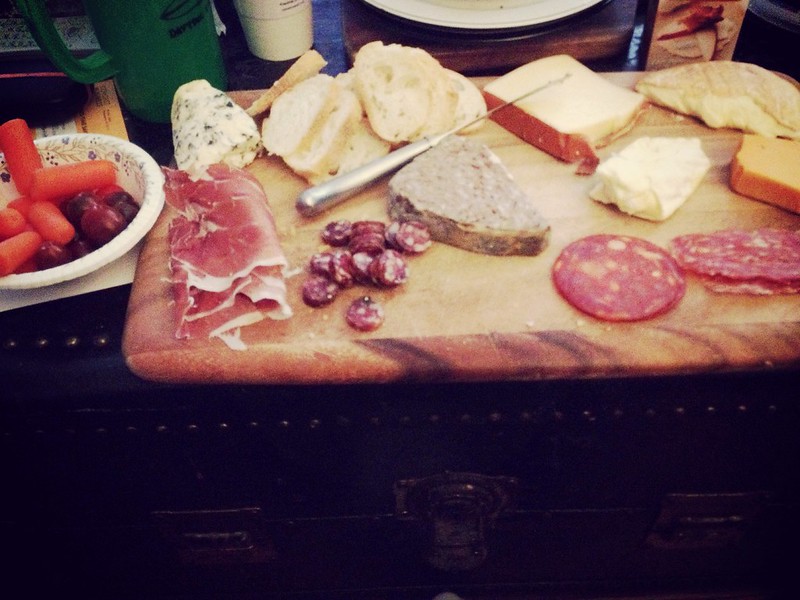Over five years ago, I blogged about starting my “Places to Eat” web application. Then about the “Places to Eat” application’s progress. I still work on it now and again, mostly adding new restaurants or city/states. You can find my list of restaurants at Gotta Eat Here.
Since then, I have been playing around with the accessibility and usability of the application. I did this to make sure the restaurant information worked for everyone.

The above photo was an excellent snack that I had while starting the research of iOS applications related to finding a place to eat, drink, attend an event, etc.
I still haven’t completed all the research on other applications that you can store places to eat. I need to do the research again and see how the applications have changed when I start over two years ago on this post.
But I have asked people I know or meet at conferences if and how they keep track of where they want to eat when traveling. I have used their feedback in my process to build something easy to use. Along with getting them the restaurant information quickly and easily.
10k Apart Contest
Years ago, An Event Apart and Microsoft put on a contest to build a web-based application in under 10 Kb. It was called 10K Apart. The contest was an easy way to code a light-weight mini-application to display all the places I liked. I have gotten other recommendations from people I know in a given city, or from blog posts/articles, or TV shows.
The plan was to build the main HTML and CSS template in three to four kilobytes. So I had six or seven kilobytes for the content. I used PHP to read in JSON files for each city that contained all the restaurant’s information.
I spent about eight or ten hours building the responsive template. The beautiful thing is there was no primary navigation, so I didn’t have to worry about that. I simply created a drop-down list of cities and states that you could choose. Then people could find out where I recommend they eat n those locations.
10K Apart Entry
The 10K Apart version was only ten restaurants per city, so when the page rendered, it was under 10 kilobytes. I wasn’t sure if the 10K Apart contest would count each page towards the total kilobyte count.
So I built the PHP code to refresh the page with the content back to itself with a full-page reload. At first, I used POST for the form, which hid the location information from the URL. Later on, I changed it to a GET. So I could send people a link that had a city parameter ( slct ) in it to save them having to look things up themselves.
After the 10K Apart Contest
I used the 10K Apart contest entry as my starting point for a much larger version. I built a more comprehensive individual city and state JSON files of places I ate or wanted to eat. I started it to have an easily accessible list for myself, or if people wanted recommendations, I could send them a link.
Since the contest ended, I have added more restaurants, cities, states, etc., that I forgot about previously. Or new places I have tried and would recommend to others since then.
Over time I have even removed a few restaurants because the last few times I went, the food was not as good as it used to be. I have also removed places that have closed. I have removed more spots during the pandemic than at any other time.
With over 75 cities/states and close to 1,000 restaurants. It’s not an easy task to check broken/redirected links. So every few months, I check each city or state using the W3c’s Link Checker. Short blog post to come on how I do that.
This reminds me that during the pandemic, I should do it more often.
Future Plans
Long term, the plan is to start posting every two weeks or so. A handful of places I recommend you should eat at in a given location or for a type of cuisine. I think a newsletter would be a reliable way to do it too. But first, I need to look into newsletters, etc. I did create a MailChimp one that I haven’t used yet that I need to find again.
I’m doing this, so I will have a shortlist for a location to share with people in the future. When they ask for recommendations for a city or places I have already been. Along with maybe a bonus place I’m looking forward to going to when it’s safe to travel.
Future Posts
Over time I plan on writing multiple posts for some of the following locations and other locations:
- Annapolis, MD
- Austin, TX
- Baltimore, MD
- Buffalo, NY
- Cleveland, PA
- Las Vegas, NV
- Memphis, TN
- Nashville, TN
- New Orleans, LA
- New York, NY
- Northern California
- Northern Virginia
- Philadelphia, PA
- Portland, OR
- Rochester, NY
- San Diego, CA
- Seattle, WA
- Southern California
- Syracuse, NY
- Washington, DC
- and many more
Conclusion
Please leave any restaurant suggestions in the comments. Along with any cities you are traveling to and want recommendations. If I have any knowledge about the locations, I will work on adding them to my list of over 75 cities or write a post about them if I already have information on them.
It would be helpful if you could please include the restaurant’s name, address (city and state), phone number, link, etc. Doing so will be helpful I’m when looking into them more.
If you want to find out more about places to eat, please register to receive an e-mail/newsletter when they are available.
